维多利亚时期的女性_women_in_victorian_age
维多利亚女王大英帝国的女王

维多利亚女王大英帝国的女王维多利亚女王:大英帝国的女王维多利亚女王(Queen Victoria)是英国历史上最长治的女王,也是维多利亚时代最为标志性的人物之一。
她的统治时期从1837年至1901年,是英国历史上一个重要的时代,被誉为“不沾染政治”的“万国压岁钱”。
一、维多利亚女王的早年生活维多利亚女王于1819年5月24日出生在肯辛顿宫。
她是父亲爱德华四世的唯一合法继承人,因此自小就备受特殊的教育。
她接受了良好的家教,在语言、音乐、绘画等方面都有很高的造诣。
二、维多利亚女王的即位历程1837年6月20日,当时18岁的维多利亚女王继承了王位,成为大英帝国的女王。
她的即位标志着维多利亚时代的开始,也是工业革命时期的重要节点。
维多利亚女王在其统治期间经历了英国工业化的高速发展,也见证了帝国的海外殖民扩张。
三、维多利亚女王的统治风格维多利亚女王统治时期相对稳定,她对政治干预并不多,因此被冠以“不沾染政治”的美誉。
她通过君主制推动了国家的稳定发展,并为大英帝国的扩张作出了积极贡献。
四、维多利亚女王的对外政策维多利亚女王时代,大英帝国经历了大规模的殖民扩张。
她积极推动英国的帝国主义政策,通过保护贸易利益、建立殖民地和扩大势力范围来加强英国在全球的影响力。
五、维多利亚女王的家庭生活维多利亚女王与德意志帝国皇帝弗里德里希三世结婚,并育有9名孩子。
她在家庭生活中扮演了温柔的母亲和贤淑的妻子的角色,对家人十分关爱。
六、维多利亚女王的文化影响维多利亚女王时代的文化繁荣,涌现出了许多重要的文学、艺术和音乐作品。
她本人也对文化艺术有着极高的兴趣,并给予了文化创作者很多的支持和鼓励。
七、维多利亚女王的晚年和影响维多利亚女王的统治持续了63年,是历史上最长时间的一个统治时期。
在她晚年时,她开始逐渐远离政治,并在1901年1月22日去世。
她的逝世标志着大英帝国维多利亚时代的结束。
维多利亚女王的统治期间,英国发生了巨大的变革,国家经济实力大幅增长,科技、文化等各个领域取得了重大进展,也为英国在世界舞台上赢得了辉煌。
维多利亚时期背景介绍THE VICTORIAN AGE
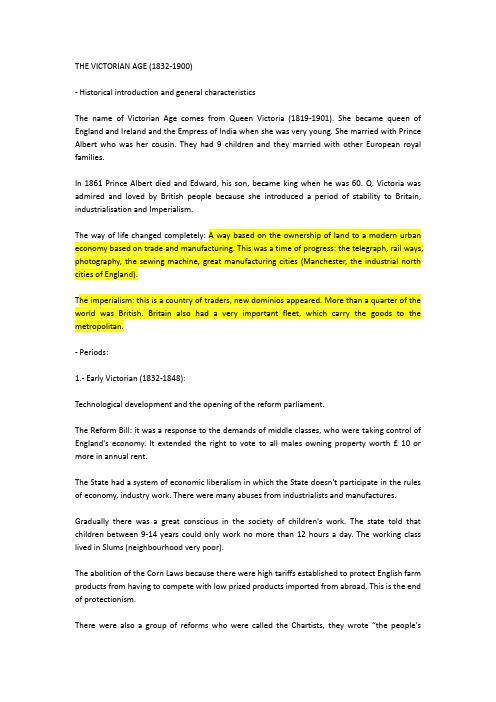
THE VICTORIAN AGE (1832-1900)- Historical introduction and general characteristicsThe name of Victorian Age comes from Queen Victoria (1819-1901). She became queen of England and Ireland and the Empress of India when she was very young. She married with Prince Albert who was her cousin. They had 9 children and they married with other European royal families.In 1861 Prince Albert died and Edward, his son, became king when he was 60. Q. Victoria was admired and loved by British people because she introduced a period of stability to Britain, industrialisation and Imperialism.The way of life changed completely: A way based on the ownership of land to a modern urban economy based on trade and manufacturing. This was a time of progress: the telegraph, rail ways, photography, the sewing machine, great manufacturing cities (Manchester, the industrial north cities of England).The imperialism: this is a country of traders, new dominios appeared. More than a quarter of the world was British. Britain also had a very important fleet, which carry the goods to the metropolitan.- Periods:1.- Early Victorian (1832-1848):Technological development and the opening of the reform parliament.The Reform Bill: it was a response to the demands of middle classes, who were taking control of England's economy. It extended the right to vote to all males owning property worth £ 10 or more in annual rent.The State had a system of economic liberalism in which the State doesn't participate in the rules of economy, industry work. There were many abuses from industrialists and manufactures.Gradually there was a great conscious in the society of children's work. The state told that children between 9-14 years could only work no more than 12 hours a day. The working class lived in Slums (neighbourhood very poor).The abolition of the Corn Laws because there were high tariffs established to protect English farm products from having to compete with low prized products imported from abroad. This is the end of protectionism.T here were also a group of reforms who were called the Chartists, they wrote “the people'scharter” (1838). It was a kind of people rights. They asked for a Universal Manhood suffrage.2.- Mid Victorian (1848-70):Because of the new inventions this is a period of prosperity (agriculture, industry...). in 1851 was “The Great Exhibition” in the Chrystal Palace, London. It shows the new inventions and congratulations of English empire.In this period there were a confrontation of ideas:Utilitarianism: it is a theory based on the idea that the rightness or wrongness of an action is determined by whether its consequences are conductive to general utility. The main thinker was Jeremy Bentham (Wrote about social happiness. He believed that individuals acted by self-interest). The utilitarians applied this idea for all the institutions, for everything.Opposed to the utilitarianism: Thomas Carlyle, he thought that intellect had limitations and couldn't explain everything and he turned to the humanism soul, a sort of religious belief was necessary to explain things.It was a group of writers who were shocked for the condition of living in some parts of England and they wrote a series of novels, “condition of England Novels” they were about living in the slums and they critiqued the oppression of working class.Elisabeth Gaskell´s “North and South” and Benjamin Disraelis “Sybil of the two nations”3.- Late Victorian: (1870-1900):The U.K. had more competitors in trade, e.g. The United States and Germany which was becoming an empire.It is a period in which workers began to join in associations, which are called trade unions. The first workers who went together were miners and textile workers. A very important association until today is called The Trade Union Congress (1868), which is the assembly of all the associations. From here we have an order of workers and a political party, Labour Party (1906)GENERAL CHARASTERISTICS OF VICTORIAN LITERATURE1. - Prose: The beginning of a new kind of prose, the lyric prose, is a prose that not only communicate ideas, it express it beautifully. In this time the readers wanted for advice from authority and some writers provided advise, people needed a guide. E.g. Thomas Carlyle, John Henry Newman, Mathew Arnold. It's full of prepositions because of this didactic style and parallelisms.2. - Poetry: It was considered superior than prose, novel theatre. They said that the writing of agenius must be poetry. There were two main romantic inheritances in poetry:1.- the use of retrospective forms: archaic language. They revived many old forms (particularly the mixture of lyric and elegy which influenced others forms like epigram).2.- experimentation with genres. Some poets continued the movement of colloquial diction into poetry (Robert Browning)3. - Novel: The main theme is man in society (family, business, friends...). they don't speak abut the past, speak about things that were happening in that time. (Dickens, Brontës).4. - Drama: Theatre had a little importance (Oscar Wilde, George Bernal Shawn)THE BRONTËS- Charlotte Brontë (1816-1855)- Emily Brontë (1818-1848)- Anne Brontë (1820-1849)Their father, Patrick Brontë was a clergyman in Yorkshire. He had six children, his mother died very soon. The four eldest were sent to a boarding school. The two eldest died of tuberculosis so the four children that remain were educated at home.He encouraged the children to learn by their own. Mr Brontë discussed poetry, history and politics with his children. The children themselves created a world of fantasy. Mr. Brontë gave his son a book of wooden soldiers, the soldiers became for them the centres of an increasingly elaborate set of manuscripts. They created new countries like Angria, Gondal. They wrote little novels of these imaginary countries.They worked as teachers and governess and they wanted to set up their own school. They wen to Brussels to study language.Branwell (the brother) was a very talented as a writer and painter, he took drugs and alcohol and died in 1848. In the funeral Emily caught a cold and it developed into tuberculosis and died in December, a year late Anne also died.- Charlotte Brontë: “Jane Eyre”, the novel examines many sides of the circumstances of women show a new move towards freedom ad equality.- Emily Brontë: “Wuthering Heights”, it is a novel of passion, an early psychological novel.- Anne Brontë: “The Tenant of Wildfell Hall” With an unusual central female character andinvolving complex relationships and problems.CHARLES DICKENSHe was born in the south of England, his father was a clerk, he went to prison and Dickens had to work in a factory (blacking workhouse) when he was 12 years old. He lived in different parts of London and knew poverty and London slums. He used this material in his novels.He became a reporter, he worked in many magazines and published in one of these magazines several sketches of the life and manners of the time these were together in one volume “Sketches by Boz”.He was asked to write “The Pickwick Papers” in 20 monthly numbers. He published his novels by instalments, he had to maintain the interest of the readers in order they want to read the following chapters. While he was writing the novel knew how was the reaction of the people, what people preferred and he could change the direction of the novel. Many critics think that the novels published in this way have a loose structure.He got married Catherine Hogarth, they had ten children, the couple separated because he had an affair with an actress. He went to America twice making them read his novels. He left his last novel unfinished.Sentimental work:- “Oliver Twist” (1837-38): it shows a great concern about social problems. He had very strong opinions against the factories in which children worked. It is a story of a poor boy that worked in a factory and describes his situation. He went away and discovered a band of thieves who taught him to be a thief. The novel is a mixture of melodrama and realism.- “The curiosity shop” (1840-41):This is the story of little Nell, a girl who lives with her grandfather. Her grandparent borrows money to a miser who takes the shop because he can't pay. They have to go away because the miser persecuted them.- “A Christmas Carol”: Scrooge a very bad miser received the visit of 3 ghosts which show past, present and the following Christmas and showed how bad he is.- “David Copperfield” (1949-50): The hero David, becomes the kind of success which Victorians admired, he is rich, he marries, and a general sense of happy ending is given. This novel was based in part of Dickens's own childhood and his success.Works after 1850:- “Bleak house”: it is a satire of the delays of law. It's a process which never ends.- “Hard Times”: it is an attack on capitalism, society and industrial life.- “A Tale of cities”: historical novel on the French revolution.- “ Great expectations”: it is about an orphan who has a secret benefactor. He help a prisoner to escape, the convict later helps him.General characteristics:He saw the world as a fresh experience. He had an extraordinary range of language, he could use colloquial and formal language. Great characters and intense emotionalism.THOMAS HARDY: “Far for the Madding Crowd”The tittle comes from the poem “Elegy written in a country churchyard”. It was published in 1874 in a magazine in serial form. He had to write in the way the readers wanted to know what was going to happen in the next chapter. It had a great success. When it was published he was 33 years old and it was his 4th novel.All Hardy's novels are settled in Wessex (the south west of England where there are a lot of counties, it is an imaginary noun).Hardy was very pessimistic and the main theme of his novels is the struggle of man against the indifferent forces that rule the world, his novels are tragic.In the first chapter, there is an introduction of the two main characters: Gabriel Oak and Bathseba; it is located in the countryside, rural setting.The narrator is omniscient, he controls everything. They are confident, they are sure of them. He goes through the novel controlling the novel, he could also change the point of view.Man in society is the main characteristic of Victorian novels. Gabriel is seen from the point of view of others.The basic idea is that he was just an ordinary man: Hardy conveys these ideas offering images of behaviour.GEORGE ELIOT (1819-1880)Her name was Mary Ann Evans, she used a pseudonym for his publications. She was born in the Church of England. At the school she converted into Methodism, which is very strict in words. She was a very cultivate woman, she was agnostic because of her intellectual formation. She translated religious texts and the critic about it. She was strongly influenced by religious concepts of love, morals, duty and behaviour.She became the assistant editor of a magazine, “The Westmister Review”. She felt strongly in love with the editor but this love was not reciprocated. Later she felt in love with Herbert Spencer but again this relation didn't go well. She met another writer G.H. Lewis, they felt in love and they went to live together until Lewis' death(1878). When he died she married her financial adviser (two years later) and seventeenth months later she died.Works:She translated many religious books. She knew Italian, German... she translated Feverbach's “Essence of Christianity”. It is important because she agreed with Feverbach view that religious beliefs are an imaginative necessity of man and a projection of his interest.Her novels were published by instalments. She has been considered the first modern English novelist.In the first generation the writers considered themselves as providers of advise and public entertainers. They wrote books to enjoy and offer them some advice. The new writers of the second generation took their job very seriously, they considered themselves as novelists, professional writers.Eliot takes her works seriously as novelists, the structure has to be perfect. She was a moral writer in the sense that she believed that the responsibility for a man's life and fate lay firmly on the individual and his moral choices. The individual has to decide in every situation and has the responsibility of his life. But the individual decisions are not external.She wrote: “Adam Bede”, “The Mill on the floss”, “Silas Marner”, “Romola, “Felix Holt”, “Middlemarch”, “Daniel Deronda”.We can represent her novels in two circles:“Middlemarch”: It was published in a serialised for. It is considered a masterpiece. The tittle is the changed name of a city where the action happens, Middlemarch is the provincial of Coventry. This novel is set during the years of the 1st reform bill. It has a multiple plot, with many arguments, several interlocking sets of characters, so she created a network that enclosed the whole life of this city.One of the stories is the story of Dorothea Brooke and Mr. Casaubon. She is an intelligent idealistic young woman and married Mr. Casaubon (a pedant). She wants to share her husband's world. When she married she realized that her husband has plans but didn't worked at them, she loses the respect of him. She begins to fell in love with Ladislaw.Another history is Dr. Lydgate, a young and very ambitious man who had plans, he wants to stablish professionally. A very beautiful woman plans to marry him, her name was Rosamand.They married but it didn't go well because she is materialist and selfish. He gets involved in some problems. In a determined point, Dorothe sees Rosemand and Ladislaw together and she decides not to love him.All the characters Know each other, at the end all the plots have relation between them, it makes a perfect portrait.THOMAS HARDY (1840-1928)He was born in Dorchester. His father was a stonemason and he worked as an apprentice to several architects, learning the profession. He began to write poetry and in the period of 1870-3 he published his first three novels, his great success came with his fourth novel, “Far from the Madding Crowd” (1874). Then he left architecture for novel writer. The most important novels that he published are “The return of the native” (1878), “The major of Casterbridge”(1886), “Tess of the D'urbervilless” (1891), and “Jude de Obscure” (1896).He became a very well known figure in London. His works were very tragic. The critics criticised his two last novels, they said that they were very immoral and pessimistic and because of this he abandoned the fiction novels and wro te only poetry, such as “Wessex Poems” (1898). He called himself “meliorist” and said that the world could be better by human effort. He received a honorary degree from Cambridge University.Work:The main theme is the struggle of man against the indifferent forces that rule the world: how people suffer because of fate who are more powerful than him. The disparity between the things that people wanted to be and the things that actually they are, between human ambition and fate. The fate is completely eternal and is important, also the social conditions.The characters are not the masters of their own fate but they can achieve dignity by endurance. He offers some sense of human in the description of rural characters.“Wesssex” is the name he gave to the south west of England. He changed the names of the places, the villages are real but the name is invented.“Tess of the D'urbervilless” : Tess is a country girl who is seduced by Alec, a rich young man, she gets pregnant and Alec leaves her. The child dies so she is very miserable, she has to work as a maid. She meets another man, angel, who is the son of a priest and they married. In the wedding night, Tess told about Alec and Angel abandoned her.Tess has to accept to become the mistress of Alec because of her bad situation. Angel returns to look for his wife, but Tess and Alec are living together. Tess gets mad and kills Alec. She is hung because of this.OSCAR WILDE (1854-1900)He was born in Dublin. His father was a very famous surgeon and his mother was a very well known poetess in Dublin. She was very controversial, provocative, excentric and Oscar had her influence. He was very estrange physically: tall, fattish, big dreamy eyes, too fleshy, big mouth, at the same time he was beautiful and awful. He dressed extravagantly because he didn't feel ashamed of his appearance.He learnt from his mother how to be funny courageous and he was a transgressor (to break the rules of society). He went to Oxford and he was a very good student. He caught syphilis from a prostitute. At the age of 29 he married Constance Lloyd. They had 2 children but soon Constance was a very sexual object for him. He convinced his wife to stop having sexual relationships, but they continued living together.By this time he wrote books of poems, tales, fairy stories. He was an excellent conversationalist, he speaks beautifully, funny, witty. Some writers said he looked like disgusted at first impression. Under this image, superficial, trivial, he was transcendent, he belonged to a poetical movement called Aestheticism whose motto is art for art sake.In 1891 Oscar met Lord Alfred Douglas (Basic) who was 21 years and Oscar 37. Basic was a young rich selfish, conceited, frivolous, cruel man. Oscar felt in love desperately in love with basic, who introduced him to the world of underground and make Oscar's life very awful. Oscar tried to leave him but he couldn't because he loved him and Bosie threatened Oscar to suicide if Oscar left him. Bosie's father was the marquis of Queensberry, he knew the relation between them and they became enemies.Meanwhile Oscar published his only novel “The portrait of Dorian Gray”, is a sort of gothic novel. Dorian wanted to be young forever. He wanted to try forbidden things.The real success came with his plays: “Lady Wardermere's fan” (1892); “A woman of no importance (1893); “An ideal husband” (1895); “The importance of being Earnest” (1895). ð Witty, funny, word plays, paradoxes.15 days after the streno of the last play Bosies's father left a note in Oscar's club accusing him of being sodomite. Oscar didn't want to answer. Bosie told Oscar to take his father to court because of difamation. The case was a hopeless case, because during the trial all the things they had done appeared and Oscar was arrested and taken to a jury. During this second case all the people he had met in the underground come to the court and told all the things they had done.He was sent to prison. Two years of force labour and his name was a matter of shame. His novels were retired of libraries; his novels never were represented again. His wife changed her surname and her child's. After 2 years he was a broken man and his friends took him to France. Oscar accepted to see Bosie again, who left him when discovered that Oscar didn't write and had lost his glamour.“The Ballad of Reading Gaol” (1898) about his prison experience.The last work published after his death “De Profundis” (1905) is a letter to reproche to Bosie, a confession.ALFRED, LORD TENNYSONHe is the Victorian poet, he wrote the model of Victorian poetry. Queen Victoria was an admirer. She was a widow for 40 years and found consolation in Tennynson's poetry. He is the poet of love and loss.His father was a priest, he was the fourth of twelve children. Their father taught them privately: classical language, philosophy, reading. He went to Cambridge and became friend of a group of artists and writers. One of them was Arthur Hallan, who was his confident, adviser, closest friend. He became engaged Arthur's sister, but died at the age of 22 and this provoqued a great depression in Tennynson, it was the origin of the poem “In Memorian” (1850)Before 1850 he had written many books of poems although they didn't became famous. He became Poet Laureate; before this publication he had the recognition of his works and it gave him a lot of money.Works:“Poems, chiefly lyrical” (1830); “in Memorian” (1850);“The charge of the light Brigade”(1854): it is inspirited on a piece of news on the newspaper about the soldiers who died in the Crimean War.“Maud” (1855): It is a monologue and best seller“Idylls of King” (1859): It is about King Arthur.General characteristics of his literature:Great virtuosity of technique. He studied the poetry of his predecessors and achieved a great technique.He had a great capacity to link scenarios to states of mind. His vision of nature is not idealistic as romantics. He prefers rural things rather than urban.Preoccupation with the problems of his days: about technological changes, he thought that it was positive but he was very worried because of horrors of industrialism (slums, working conditions, working of the children).He was an admirer of Yeats.“In Memorian”He started it in 1833. It is a series of poems put together around the same theme: the death of his friend. More than an elegy is a group of poems about anxieties and doubts about the meaning of life, what a rule of a man was in the world and doubts because of the death of his friend. It is a poet diary upon his reflections on this matter.ROBERT BROWNING (1812-1889)/ ELISABETH BROWNING (1806-1861)Robert is admired for two things:moral toneinnovations in poetry- Robert browning was born in London, he was the son of a banker, and educated basically at home because his father had a great library and he read a lot.At the beginning he wrote personal poems. Some critics attacked his poems and he was embarrassed because of this, so he changed his way of writing( very personal), which became more obscure.After 1936 and during ten years, he wrote plays but without success, but it was a good practice for a new model of poetry which he developed; dramatic monologue. It was his best known kind of poetry because he could write in a personal way under a character.“Dramatics Lyrics” (1842) it was the first collection of this kind of poetry.After 15 years in Italy, he and his son came back to England. He wrote “Dramatis Personae” (1864) which was a monologue; “The Ring and the Book”.- Elizabeth was a very well known poet who was semi-invalid, under the control of her father. She was kept at home, she had a tyrannical father, she was very well educated.She published “Poems” (1844) and Robert read it and enjoyed it very much and they stablished a correspondence. After a time they became engaged secretly. In 1846 they got married secretly and eloped to Italy and stayed there for 15 years. There she discovered that she wasn't invalid and they were very happy. The product of their love is “ Sonnets from the Portuguese” (1850): a sequence of forty four sonnets in which she recorded the stages of her love for Robert Browning, a sequence she presented under the guise of a translation from the Portuguese language.“Aurora Leigh”(1857)Differences between Browning and TennysonTennyson was the Victorian poet who was worried with the topics of the age. But he explored the topics of the day in a different way: faith/doubt, Good/evil.The main difference is the style. Tennyson belonged to the lyrical tradition. Browning had a more colloquial, prosaic tone, his poems are like prose.The social world within which this dilema has to be resolvedThe centre of her novelsA small group of individuals involved in a normal dilema。
维多利亚时期新女性的代表——淑·布莱德赫人物形象浅析
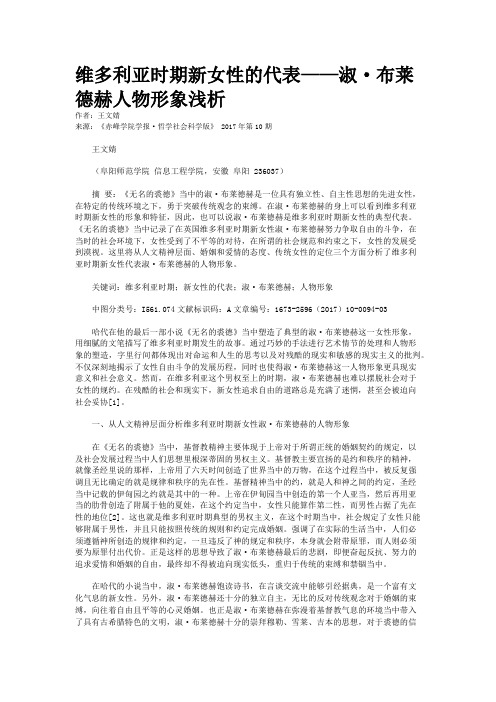
维多利亚时期新女性的代表——淑·布莱德赫人物形象浅析作者:王文婧来源:《赤峰学院学报·哲学社会科学版》 2017年第10期王文婧(阜阳师范学院信息工程学院,安徽阜阳 236037)摘要:《无名的裘德》当中的淑·布莱德赫是一位具有独立性、自主性思想的先进女性,在特定的传统环境之下,勇于突破传统观念的束缚。
在淑·布莱德赫的身上可以看到维多利亚时期新女性的形象和特征,因此,也可以说淑·布莱德赫是维多利亚时期新女性的典型代表。
《无名的裘德》当中记录了在英国维多利亚时期新女性淑·布莱德赫努力争取自由的斗争,在当时的社会环境下,女性受到了不平等的对待,在所谓的社会规范和约束之下,女性的发展受到漠视。
这里将从人文精神层面、婚姻和爱情的态度、传统女性的定位三个方面分析了维多利亚时期新女性代表淑·布莱德赫的人物形象。
关键词:维多利亚时期;新女性的代表;淑·布莱德赫;人物形象中图分类号:I561.074文献标识码:A文章编号:1673-2596(2017)10-0094-03哈代在他的最后一部小说《无名的裘德》当中塑造了典型的淑·布莱德赫这一女性形象,用细腻的文笔描写了维多利亚时期发生的故事。
通过巧妙的手法进行艺术情节的处理和人物形象的塑造,字里行间都体现出对命运和人生的思考以及对残酷的现实和敏感的现实主义的批判。
不仅深刻地揭示了女性自由斗争的发展历程,同时也使得淑·布莱德赫这一人物形象更具现实意义和社会意义。
然而,在维多利亚这个男权至上的时期,淑·布莱德赫也难以摆脱社会对于女性的规约。
在残酷的社会和现实下,新女性追求自由的道路总是充满了迷惘,甚至会被迫向社会妥协[1]。
一、从人文精神层面分析维多利亚时期新女性淑·布莱德赫的人物形象在《无名的裘德》当中,基督教精神主要体现于上帝对于所谓正统的婚姻契约的规定,以及社会发展过程当中人们思想里根深蒂固的男权主义。
高一英语西方服饰单选题40题

高一英语西方服饰单选题40题1. In the Victorian era, women often wore long dresses made of _____.A. silkB. cottonC. woolD. nylon答案:A。
本题考查西方传统服饰的材质。
在维多利亚时代,丝绸是女性常用来制作长裙的高档材质。
选项 B 棉花,相对较普通;选项C 羊毛,常用于秋冬服装;选项D 尼龙是现代合成材料,当时未被广泛使用。
2. The traditional Scottish kilt is usually made of _____.A. leatherB. linenC. velvetD. tartan答案:D。
此题关于苏格兰传统服饰。
苏格兰方格呢短裙通常是用格子呢(tartan)制成。
选项A 皮革,不常用于制作短裙;选项B 亚麻,不是其主要材质;选项C 天鹅绒,也不是传统苏格兰短裙的常见材质。
3. During the Renaissance, men's clothing was often decorated with _____.A. jewelsB. feathersC. buttonsD. lace答案:C。
文艺复兴时期,男士服装常以纽扣 buttons)作为装饰。
选项A 珠宝,过于昂贵;选项B 羽毛,不太常见;选项D 蕾丝,多用于女性服装。
4. The ancient Greek toga was mainly made of _____.A. silkB. woolC. linenD. cotton答案:C。
古希腊的托加袍主要由亚麻(linen)制成。
选项A 丝绸,并非主要材质;选项B 羊毛,不太符合;选项D 棉花,当时不是主要用料。
5. In the Middle Ages, noblewomen wore gowns made of _____.A. satinB. chiffonC. velvetD. damask答案:D。
维多利亚时代女性的标准

维多利亚时代女性的标准此文主要从三个方面介绍了维多利亚女性特点。
首先文章介绍了十九世纪兴起的女权主义运动,从运动的起因,过程和特点阐述分析维多利亚时代女性的特征。
然后,文章描述了英国文学界的一次女性创作高峰,即维多利亚时代女性写作的兴起。
在这个部分,文章对女性写作兴起的原因,女性作家写作特色进行了分析。
最后,文章讲述了维多利亚时代贵族女性的特点,从政治,经济,婚姻三个方面对她们的生活状况进行了大体描述。
关于维多利亚时代女性,不得不说到女权主义(feminism)运动。
西方的女权主义发展分为三个阶段,第一个阶段即发生在维多利亚时期,和工业**同步,也就是19世纪下半叶。
在19世纪以前,女性社会地位身份低下,尤其是已婚女子,被认为只是男性的附属品,几乎失去了自由,存在感十分微弱。
女性不能做自己喜欢的工作,她们的活动范围基本被局限在家庭,社交场合,因而女性的创造力也受到了压制和忽视。
女性在社会显然处于弱势,可是女性并没有因为弱小而收到保护,恰恰相反,在家庭或者公共场所,女性常常受到攻击和骚扰。
由此看来,当时的女性面临着自我意识的觉醒问题,当女性渐渐意识到只有依靠自己的奋斗才可能获得成功,获得社会的认可时,女权主义运动也就顺着历史的潮流产生了。
维多利亚时代早期,下层劳动女性为了面包而工作,广大中产阶级女性为了权力而斗争。
由于劳动女性斗争意识的增长和女权主义的呼吁,英国制定了保护妇女和儿童的法律。
维多利亚时代中期,这一阶段的斗争主要采取了请愿的方式,广大女性纷纷组织社会团体,上街进行宣传讲演,在社会上扩大女权运动的影响,给议会施加压力,以迫使议会通过女性的要求。
女权运动在进入维多利亚时代晚期之初,依然延续着维多利亚时代中期的斗争方式,主要采取舆论宣传,组织请愿等方式。
19世纪80年代,相续出现一批女权运动的团体。
到1894年时,女性争取参政权的斗争有了一定效果,已婚妇女获得了在地方上的选举权。
在女王去世的的头两年,一些激进的女权运动者认为通过和平请愿获得参政权力的方式已经过时,一些女权组织开始使用暴力手段进行抗议,运动更加激进化。
从《我的前公爵夫人》看维多利亚时期女性的社会地位
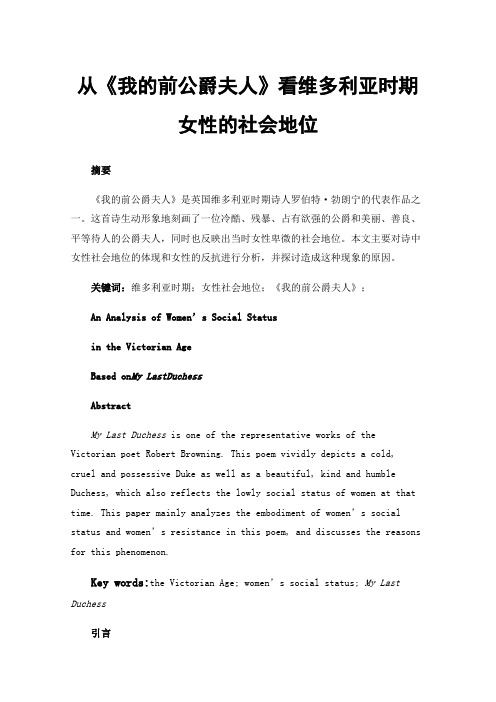
从《我的前公爵夫人》看维多利亚时期女性的社会地位摘要《我的前公爵夫人》是英国维多利亚时期诗人罗伯特·勃朗宁的代表作品之一。
这首诗生动形象地刻画了一位冷酷、残暴、占有欲强的公爵和美丽、善良、平等待人的公爵夫人,同时也反映出当时女性卑微的社会地位。
本文主要对诗中女性社会地位的体现和女性的反抗进行分析,并探讨造成这种现象的原因。
关键词:维多利亚时期;女性社会地位;《我的前公爵夫人》;An Analysis of Women’s Social Statusin the Victorian AgeBased on My LastDuchessAbstractMy Last Duchess is one of the representative works of theVictorian poet Robert Browning. This poem vividly depicts a cold, cruel and possessive Duke as well as a beautiful, kind and humble Duchess, which also reflects the lowly social status of women at that time. This paper mainly analyzes the embodiment of women’s social status and women’s resistance in this poem, and discusses the reasons for this phenomenon.Key words:the Victorian Age; women’s social status; My Last Duchess引言维多利亚时代,前接乔治王时代,后启爱德华时代,其时限常被定义为1837年至1901年,即维多利亚女王统治时期。
勃朗特姐妹与维多利亚时代女性艺术
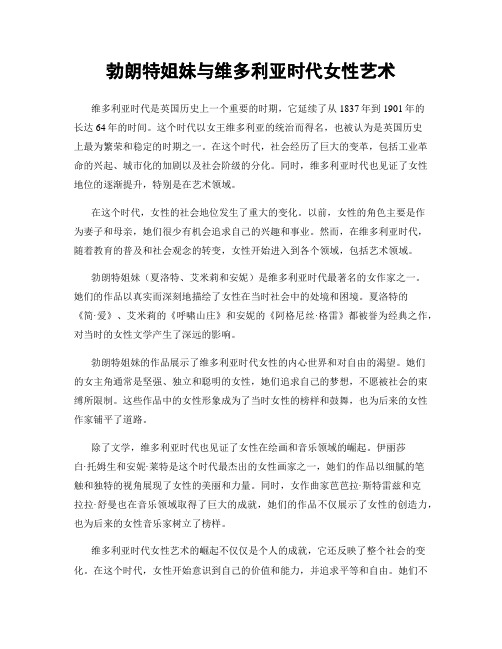
勃朗特姐妹与维多利亚时代女性艺术维多利亚时代是英国历史上一个重要的时期,它延续了从1837年到1901年的长达64年的时间。
这个时代以女王维多利亚的统治而得名,也被认为是英国历史上最为繁荣和稳定的时期之一。
在这个时代,社会经历了巨大的变革,包括工业革命的兴起、城市化的加剧以及社会阶级的分化。
同时,维多利亚时代也见证了女性地位的逐渐提升,特别是在艺术领域。
在这个时代,女性的社会地位发生了重大的变化。
以前,女性的角色主要是作为妻子和母亲,她们很少有机会追求自己的兴趣和事业。
然而,在维多利亚时代,随着教育的普及和社会观念的转变,女性开始进入到各个领域,包括艺术领域。
勃朗特姐妹(夏洛特、艾米莉和安妮)是维多利亚时代最著名的女作家之一。
她们的作品以真实而深刻地描绘了女性在当时社会中的处境和困境。
夏洛特的《简·爱》、艾米莉的《呼啸山庄》和安妮的《阿格尼丝·格雷》都被誉为经典之作,对当时的女性文学产生了深远的影响。
勃朗特姐妹的作品展示了维多利亚时代女性的内心世界和对自由的渴望。
她们的女主角通常是坚强、独立和聪明的女性,她们追求自己的梦想,不愿被社会的束缚所限制。
这些作品中的女性形象成为了当时女性的榜样和鼓舞,也为后来的女性作家铺平了道路。
除了文学,维多利亚时代也见证了女性在绘画和音乐领域的崛起。
伊丽莎白·托姆生和安妮·莱特是这个时代最杰出的女性画家之一,她们的作品以细腻的笔触和独特的视角展现了女性的美丽和力量。
同时,女作曲家芭芭拉·斯特雷兹和克拉拉·舒曼也在音乐领域取得了巨大的成就,她们的作品不仅展示了女性的创造力,也为后来的女性音乐家树立了榜样。
维多利亚时代女性艺术的崛起不仅仅是个人的成就,它还反映了整个社会的变化。
在这个时代,女性开始意识到自己的价值和能力,并追求平等和自由。
她们不再满足于被动地接受社会的安排,而是积极地争取自己的权益和机会。
女性的艺术作品成为了她们表达自己的途径,也为后来的女性艺术家提供了宝贵的经验和启示。
不屈的反抗,无奈的结局——《德伯家的苔丝》和《嘉莉妹妹》中女主角的对比分析

本人呈交给山东科技大学的这篇硕士学位论文,除了所列参考文献论文资料尚没有呈交与其他任何学术机关作鉴定。
硕士生签名:
日期:
AFFIRMATIOIN
I declare that this thesis, submitted in partial fulfillment of the requirements for the award of Master of Arts in Shandong University of Science and Technology, is my own work except the parts indicated in the references. The document has not been submitted for qualification at any other academic institution.
信阳师范学院
硕士学位论文
不屈的反抗,无奈的结局--《德伯家的苔丝》和《嘉莉妹妹
》中女主角的对比分析
姓名:***
申请学位级别:硕士
专业:英语语言文学
指导教师:***
201104
不屈的反抗,无奈的结局——《德伯家的苔丝》和《嘉莉妹妹
山 东 科 技 大 学
二零一二年六月
论文题目:
人性的信仰:神话原型视角下的《织工
马南》主题阐释
作者姓名: 钱瑞燕 入学时间:2009年9月专业名称:英语语言文学 研究方向:英 国 文 学指导教师: 张 琳 职 称:副 教 授
论文提交日期:2012年5月
Chapter One intends to identify the archetypal theme in the novel. With a brief discussion of the myth-archetypal criticism and the archetypal characteristic of Silas Marner, Chapter One analyses the hero’s pilgrimage in belief so as to reveal the writer’s intention of creation. People who frequently emerge as “Christian” and “Angel” in Eliot’s works have archetypal significance. The theme of the novel is full of religious sentiment by adopting the traditional Bible culture. To some extent, it reports the process of Eliot’s pursuit of faith in humanity. Besides, it proves that Eliot inherits the tradition of Victorian literature. Therefore, the archetypal theme of Silas Marner concretely interprets Eliot’s humanistic ideal. Chapter Two expounds the cultural meaning and art function of the myth-archetypal plots based on the reading of Silas Marner. Both the structure of the complicated mythological plots and the usage of mythic coincidences are the objective correlative of creation method, which aim to reveal the power and variability of fate and unravel the sins under the coincidences. In character design, Eliot intentionally emphasizes the two heroes’ differences in personality and fate. On the one hand, she highlights Marner’s unsophisticated personality and his legend of undergoing hardships and returning to the trueness, goodness and beauty. On the other hand, she depicts Godfrey as a representative of the complicacy and hypocrisy of human nature. He
维多利亚女王的历史故事
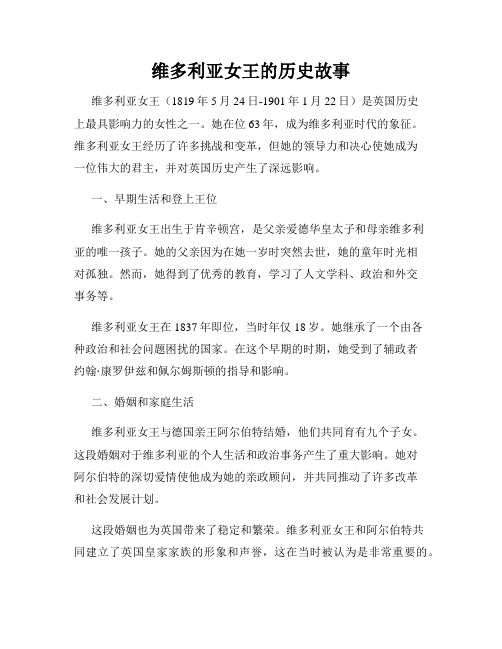
维多利亚女王的历史故事维多利亚女王(1819年5月24日-1901年1月22日)是英国历史上最具影响力的女性之一。
她在位63年,成为维多利亚时代的象征。
维多利亚女王经历了许多挑战和变革,但她的领导力和决心使她成为一位伟大的君主,并对英国历史产生了深远影响。
一、早期生活和登上王位维多利亚女王出生于肯辛顿宫,是父亲爱德华皇太子和母亲维多利亚的唯一孩子。
她的父亲因为在她一岁时突然去世,她的童年时光相对孤独。
然而,她得到了优秀的教育,学习了人文学科、政治和外交事务等。
维多利亚女王在1837年即位,当时年仅18岁。
她继承了一个由各种政治和社会问题困扰的国家。
在这个早期的时期,她受到了辅政者约翰·康罗伊兹和佩尔姆斯顿的指导和影响。
二、婚姻和家庭生活维多利亚女王与德国亲王阿尔伯特结婚,他们共同育有九个子女。
这段婚姻对于维多利亚的个人生活和政治事务产生了重大影响。
她对阿尔伯特的深切爱情使他成为她的亲政顾问,并共同推动了许多改革和社会发展计划。
这段婚姻也为英国带来了稳定和繁荣。
维多利亚女王和阿尔伯特共同建立了英国皇家家族的形象和声誉,这在当时被认为是非常重要的。
三、对帝国的影响维多利亚女王的统治期间,英国的领土和影响力不断扩大。
她成为大英帝国的君主,并在全球范围内建立了英国的统治地位。
维多利亚女王的统治带来了工业革命和科学技术的蓬勃发展。
英国在这个时期成为全球最强大的国家之一。
她的领导也帮助英国走向了现代民主国家的形式。
四、个人悲剧和后期统治维多利亚女王在她的统治后期经历了一些个人悲剧,包括丈夫阿尔伯特的早逝和她最年轻的儿子利奥波德的不幸去世。
这些个人悲剧对她的精神健康产生了一定的影响,她渐渐地退居幕后,不再积极参与政治事务。
1901年,维多利亚女王去世,结束了她长达半个世纪的统治。
她的死引起了全国范围内的哀悼,并成为英国历史上一个重要的转折点。
结语维多利亚女王作为英国历史上最有影响力的女性之一,对英国和全球产生了深远的影响。
维多利亚女王

• 这个时期,英国盛行下午茶,贵族们早餐丰 富,午饭简单,晚饭很晚。据说,维多利亚 女王的女侍从官——女公爵安娜每到下午就 会觉得很饿,于是便让仆人拿些小茶点来吃, 许多人纷纷效仿,下午茶渐渐成为一种例行 仪式。事实上,围绕着这种下午茶习俗形成 了多彩的茶文化,高雅的旅馆开始设起茶室, 街上有了向公众开放的茶馆,茶话舞会更成 为一种社会形式,维多利亚时代的淑女小姐 们在那里与男友们会面。
• 这个令人神往的时代,并没有随着 维多利亚女王的去世而结束。很多 历史学家认为,所谓“维多利亚时 代”的真正结束,是在第一次世界 大战结束以后。而令我们中国人印 象深刻的是1840年,中英爆发鸦 片战争。中国由此渐渐步入半殖民 地深渊。而当时,英国正处于“维 多利亚时代”。
亚利山德拉· 维多利亚于1837年继承王位 (当时她18岁),统治英国直到1901年逝 世,是英国历史上统治时间最长的一位君主。 她统治英国近一段时期被称为“维多利亚时 代”。是英国历史上最为光辉灿烂的盛世。 维多利亚时代被认为是英国工业革命的 顶点时期,也是大英帝国经济文化的全 盛时期 。
维多利亚女王(Queen Victoria),1819年5月24 日生于伦敦肯辛顿宫,1901年1月22日逝于怀特岛。 母亲是德国公主,父亲逝肯特公爵爱德华。1837年 威廉四世(她的叔父)去世,维多利亚成为女王, 时年18岁。1838年6月28日在威斯敏斯特大教堂加 冕。1840年维多利亚与大表兄萨克森-科堡-哥达亲 王阿尔伯特结婚。她生有9哥孩子。长女后为德国皇 后和德皇威廉二世的母亲,有一个孙女当上俄国的 末代女皇。到19世纪末,维多利亚女王由于拥有许 多欧洲皇室的皇亲国戚,被人称为“欧洲的祖母”。 1876年维多利亚成为印度女皇。在英国历史上,维 多利亚统治的时间最长,1897年英国为她在位60周 年举行庆典。
维多利亚时代服饰特点
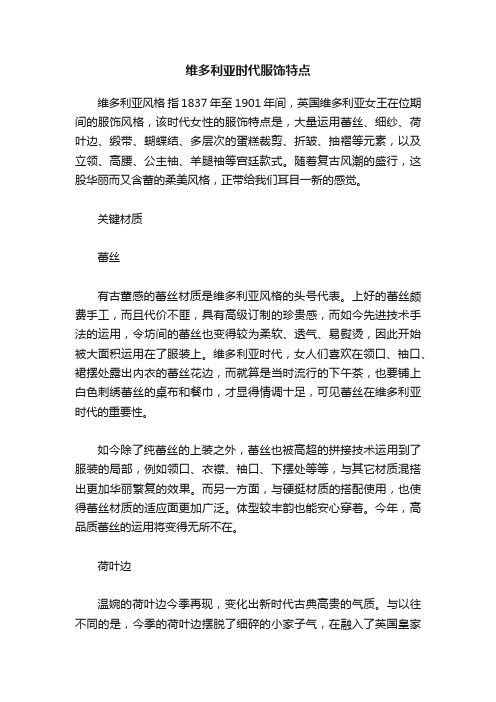
维多利亚时代服饰特点维多利亚风格指1837年至1901年间,英国维多利亚女王在位期间的服饰风格,该时代女性的服饰特点是,大量运用蕾丝、细纱、荷叶边、缎带、蝴蝶结、多层次的蛋糕裁剪、折皱、抽褶等元素,以及立领、高腰、公主袖、羊腿袖等宫廷款式。
随着复古风潮的盛行,这股华丽而又含蓄的柔美风格,正带给我们耳目一新的感觉。
关键材质蕾丝有古董感的蕾丝材质是维多利亚风格的头号代表。
上好的蕾丝颇费手工,而且代价不匪,具有高级订制的珍贵感,而如今先进技术手法的运用,令坊间的蕾丝也变得较为柔软、透气、易熨烫,因此开始被大面积运用在了服装上。
维多利亚时代,女人们喜欢在领口、袖口、裙摆处露出内衣的蕾丝花边,而就算是当时流行的下午茶,也要铺上白色刺绣蕾丝的桌布和餐巾,才显得情调十足,可见蕾丝在维多利亚时代的重要性。
如今除了纯蕾丝的上装之外,蕾丝也被高超的拼接技术运用到了服装的局部,例如领口、衣襟、袖口、下摆处等等,与其它材质混搭出更加华丽繁复的效果。
而另一方面,与硬挺材质的搭配使用,也使得蕾丝材质的适应面更加广泛。
体型较丰韵也能安心穿着。
今年,高品质蕾丝的运用将变得无所不在。
荷叶边温婉的荷叶边今季再现,变化出新时代古典高贵的气质。
与以往不同的是,今季的荷叶边摆脱了细碎的小家子气,在融入了英国皇家气质后,大大地舒展了开来,造型更加大气,轻柔飞扬地蔓延在整个肩部和胸部。
另一方面,荷叶边也配合圆裙的裁剪,加以垂缀感的线条修饰,融维多利亚时代与爱德华时代于一体,更加具有贵族高雅的神韵。
其中最著名的是维多利亚风格的蛋糕裙,本季无论是搭配休闲服饰的膝上蛋糕裙,还是出席酒会的长蛋糕裙,都十分受欢迎,能凸现维多利亚式的华丽典雅精神。
包纽在维多利亚的典雅之下,纽扣也不再无足轻重,精致、考究的材质成为了你不可忽略的细节所在。
仿珍珠纽扣十分优雅,而更盛行的是包纽,用与服装同材质的真丝或绸缎将纽扣包住,呈现出浑然一体的装饰感,同时,也体现出犹如手工定制般的缜密做工。
维多利亚时代的时尚

维多利亚时代的时尚维多利亚时代是指1837年至1901年间,英国女王维多利亚执政的时期。
在这个时期,英国的社会和经济都发生了巨大的变化,这也导致了时尚的变化和演变。
维多利亚时代的时尚被认为是十分传统和保守的,但其实它也包含了很多不同的风格和流派。
维多利亚时代的时尚可以分为几个时期:初期维多利亚时期(1837年-1860年)、高峰维多利亚时期(1860年-1890年)和晚期维多利亚时期(1890年-1901年)。
每个时期都有其独特的特点和风格。
在初期维多利亚时期,女性的服装十分宽松,也十分朴素,主要由宽大的裙子,低腰线的上衣和宽松的袖子组成。
裙子通常是由许多层衬裙和外衣裙组成,上衣通常是高领的,有时还有领子和蝴蝶结。
这种流行趋势主要是由于维多利亚女王的个人喜好,她常常穿着类似的服装出现在公众面前。
随着时光的流逝,维多利亚时代的服装逐渐变得复杂,这也是高峰维多利亚时期的特点。
在这个时期,女性的服装开始慢慢变得修身,同时也增加了许多装饰,如绣花、褶裥和蕾丝。
同时,腰线也开始向上移动,由低腰线变成了自然腰线。
在这个时期,紫外光灯被广泛使用于制衣之中。
在这个时期,约瑟芬皇后成为时尚的偶像,她喜欢艳丽的颜色和华丽的装饰。
许多时装设计师开始从约瑟芬皇后的着装中汲取灵感,创造出了许多华丽、缤纷的服装设计。
晚期维多利亚时期的时尚主要由于女性开始参与大众活动,如骑车、游泳、网球等,女性的服装也逐渐变得更加实用。
裙子长度开始在膝盖以上,为了方便活动也增加了更多的口袋和挂钩。
同时,袖子也变得更加简单,通常比较修身,配有一些精致的装饰。
总的来说,维多利亚时代的时尚可以看作是品味和气质的象征。
虽然在这个时期的服装中有许多规矩和限制,但也包含着大量的创意和艺术。
现在,人们还能看到很多与维多利亚时代服装的影子,这说明其影响仍能影响当今的时尚设计。
妇女在维多利亚时期的地位
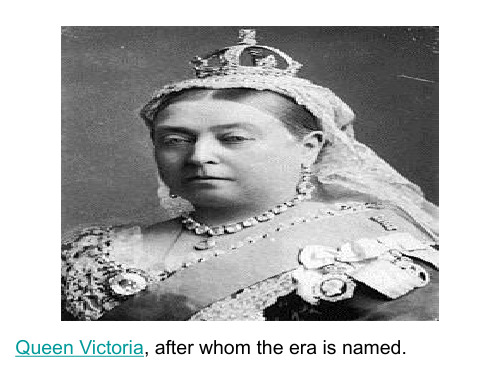
Social taboos surrounding the female body
• The body of the woman was seen as pure and clean except when she was experiencing menstruation. Women often did not wear any kind of cosmetics or any other adornments. It was taboo to even mention the words "leg" or "breast." Women covered their legs to a much greater extreme than they do today. Even the bare skin of an ankle was considered risque. In contrast, cleavage was not sexualized to the extent that it is today. Cleavage lines that would be normal by some of today's standards would have been controversial for even the most "decent" middle-class woman in Victorian England.
Queen Victoria, after whom the era is named.
Women in the Victorian era
• The status of women in the Victorian era is often seen as an illustration of the striking discrepancy between the national power and wealth and what many, then and now, consider its appalling social conditions. During the era symbolized by the reign of British monarch Queen Victoria, women did not have suffrage rights, the right to sue, or the right to own property. Discrimination was rampant surrounding the idealistic impression that aristocratic women should be "pure" and "clean." This paradoxical form of repression used positive words to restrict upper-class Victorean-era women from becoming "dirty" with the jobs that would have provided them with economical freedom and the lifestyles that would have provided them with social freedom. It was sometimes even claimed that "decent" women were untroubled by sexual pleasure. In stark contrast to Queen Victoria, the powerful female monarch of the time, the duties of the average upper-class woman were to maintain children and the house. Upper-class professional women faced great discrimination in employment beyond the role of children's teacher.
英国维多利亚时期的女性地位演变

英国维多利亚时期的女性地位演变英国维多利亚时期,从1837年至1901年,是女性社会地位出现显著变化的重要历史时期。
在此期间,女性的社会角色、家庭地位、教育和职业选择都发生了巨大变化。
然而,在这个时代之前,女性的社会地位是非常低下的。
一、英国维多利亚时期女性的社会角色在维多利亚时期之前,女性被视为家庭的一部分,既不能在社会中公开出现,也不能向外界展示自己的才能。
女性的社交场合被限制在家庭、教堂和慈善机构里。
大多数女人只有在结婚之后才会有自己的社交圈。
妇女们并没有得到公正待遇,因为她们的财产和收入都被她们的丈夫完全控制。
女性也不能继承地产或同男性一般承袭家庭的头衔和财产。
所以女性在当时是没有真正意义上的社会地位的。
然而,在维多利亚时期,随着工业革命、科技的快速发展和现代化的到来,女性的社会地位开始发生变化。
由于工业革命的影响,工厂需要更多的员工,这为妇女提供了就业的机会。
尤其在纺织工业中,女工的数量占到了全部员工的三分之一。
一些妇女也开始了自己的生意和工作,例如开办小型的出版社、艺术品店、裁缝店等等。
这些都意味着妇女在社会中扮演着越来越多的角色。
二、维多利亚时期女性的家庭地位在维多利亚时期,女性在家庭中的地位和角色改变了很多。
随着城镇化的加速,家庭结构从传统的大家庭式向核心家庭转移,家庭领导地位开始从父亲转移到丈夫。
到了19世纪中期,妇女在家庭中的地位显然提高了许多,成为家庭的管理人员、财政主管和妻子。
这时的家庭形态使妇女更能够寻求更好的家族关系,妇女的地位也随之提高。
此外,在维多利亚时期中的领导型妇女也很受欢迎,她们成为了女性运动的倡导者。
妇女开始参与运动,提出了许多与女性权益、女性地位和妇女教育等方面相关的议题。
从这个角度看,维多利亚时期是一段关于女性影响社会的重要时期。
三、维多利亚时期女性的教育和职业选择在维多利亚时期,女性的职业选择变得越来越多,她们的教育也变得更加重要。
首先,女儿的受教育程度比此前增加了很多。
维多利亚女王英国历史上的女性统治者
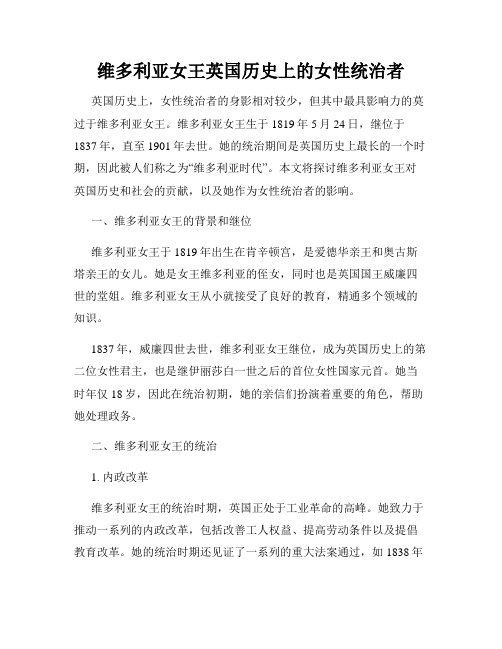
维多利亚女王英国历史上的女性统治者英国历史上,女性统治者的身影相对较少,但其中最具影响力的莫过于维多利亚女王。
维多利亚女王生于1819年5月24日,继位于1837年,直至1901年去世。
她的统治期间是英国历史上最长的一个时期,因此被人们称之为“维多利亚时代”。
本文将探讨维多利亚女王对英国历史和社会的贡献,以及她作为女性统治者的影响。
一、维多利亚女王的背景和继位维多利亚女王于1819年出生在肯辛顿宫,是爱德华亲王和奥古斯塔亲王的女儿。
她是女王维多利亚的侄女,同时也是英国国王威廉四世的堂姐。
维多利亚女王从小就接受了良好的教育,精通多个领域的知识。
1837年,威廉四世去世,维多利亚女王继位,成为英国历史上的第二位女性君主,也是继伊丽莎白一世之后的首位女性国家元首。
她当时年仅18岁,因此在统治初期,她的亲信们扮演着重要的角色,帮助她处理政务。
二、维多利亚女王的统治1. 内政改革维多利亚女王的统治时期,英国正处于工业革命的高峰。
她致力于推动一系列的内政改革,包括改善工人权益、提高劳动条件以及提倡教育改革。
她的统治时期还见证了一系列的重大法案通过,如1838年工厂法案、1844年工厂法案等,这些措施极大地改善了工人的生活状况。
2. 帝国的边界扩张在维多利亚女王的统治下,英国实现了延伸帝国版图的边界扩张。
英国殖民地得到了进一步发展,其中包括印度、加拿大、澳大利亚和新西兰等地。
这些殖民地的资源为英国提供了巨大的财富和实力,进一步巩固了英国在全球范围内的影响力。
3. 文化和社会影响维多利亚女王时期的英国社会经历了巨大的变革。
维多利亚女王本人颇有文化修养,她对于文学、音乐和戏剧的热爱也对英国文化发展起到了重要推动作用。
维多利亚女王的个人兴趣在一定程度上影响了整个社会,促进了文学艺术的繁荣。
三、维多利亚女王作为女性统治者的影响维多利亚女王作为英国历史上的女性统治者,产生了深远的影响。
她的统治时期被视为女性解放的象征,证明了女性也能胜任起国家元首的角色。
维多利亚女王的一生简介

女王与鸦片战争
• 1837年维多利亚女王尚未登基时,英国已经率先 完成了工业革命,为了满足国家寻求生产原料和 销售市场的目的,英国迫切地开始了对外国的侵 略。在占领新西兰(标志着英国在全世界的殖民 体系形成)之后,英国将矛头指向了中国。 • 在1839年,英国商人在政府支持之下向中国倾销 鸦片,经历过虎门销烟后,1840年,维多利亚女 王在议会上发表了著名的演说,呼吁“为了大英 帝国的利益,向中国发动战争”,至此,第一次 鸦片战争拉开了序幕。
名花倾国两相欢
——一个女Leabharlann 的传奇• • • •有一个女人,年纪轻轻登上皇位。 有一个女人,统治一个帝国长达64年。 有一个女人,爱情事业双丰收。 有一个女人,以她的名字命名了一整个时 代。 • 有一个女人,是历史上一段不朽的传奇。
• Who is She?
维多利亚女王
• • • • • • 在世日期: 1819.5.24——1901.1.22 在位日期: 1837.6.20——1901.1.22 加冕日期: 1838.6.28
花自飘零
• 1901年1月22日,维多利亚女王猝于怀特岛—— 她和她的丈夫最喜欢的地方。 • 英国人听闻她的死讯,简直是如同世界末日来临 一般。最恶毒的政治评论家也无法否认,在她统 治期间,英国空前繁华,强大,并且还在不断发 展。这是女王留下的最大的遗产,同时也是对她 一生最完美的概括和评价。 • 没有哪一个坐上帝位的女人能像她一样,如此出 色地完成了女王的职责,同时也获得了普通女人 鹣鲽情深,儿孙满堂的幸福。
女王的童年
• 1819年5月24日,维多利亚降生在伦敦的肯辛顿 王宫,父亲爱德华王子是英王乔治三世的第四子, 母亲则是德国-萨克森-科堡-萨尔菲尔德的维多利 亚公主,对于她来说,这个女儿格外值得珍视, 因为只有她才有希望登上王位。 • 父母为了女王的取名费尽心思,最终定为亚力山 德琳娜· 维多利亚,一是为了纪念她的教父,俄国 的亚历山大一世,另一则是为了纪念她的母亲。 • 而这位传奇女王的童年并不幸福,她的父亲在她 八个月大时离开人世,留下了沉重的债务,使得 年幼的维多利亚公主时常穿着一套衣服,从此开 始节俭度日。即使即位之后也保持了简朴的风格。
维多利亚时期的英国女性的家庭观
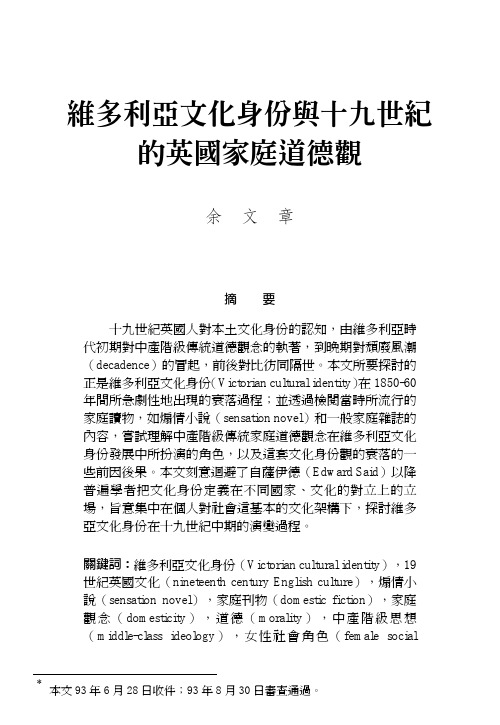
維多利亞文化身份與十九世紀的英國家庭道德觀余 文 章摘 要十九世紀英國人對本土文化身份的認知,由維多利亞時代初期對中產階級傳統道德觀念的執著,到晚期對頹廢風潮(decadence)的冒起,前後對比彷同隔世。
本文所要探討的正是維多利亞文化身份(Victorian cultural identity)在1850-60年間所急劇性地出現的衰落過程;並透過檢閱當時所流行的家庭讀物,如煽情小說(sensation novel)和一般家庭雜誌的內容,嘗試理解中產階級傳統家庭道德觀念在維多利亞文化身份發展中所扮演的角色,以及這套文化身份觀的衰落的一些前因後果。
本文刻意迴避了自薩伊德(Edward Said)以降普遍學者把文化身份定義在不同國家、文化的對立上的立場,旨意集中在個人對社會這基本的文化架構下,探討維多亞文化身份在十九世紀中期的演變過程。
關鍵詞:維多利亞文化身份(Victorian cultural identity),19世紀英國文化(nineteenth century English culture),煽情小說(sensation novel),家庭刊物(domestic fiction),家庭觀念(domesticity),道德(morality),中產階級思想(middle-class ideology),女性社會角色(female social∗本文93年6月28日收件;93年8月30日審查通過。
126中外文學.第33卷.第6期.2004年11月roles),男性社會角色(male social roles),兩性關係(maleand female sexuality),頹廢文化(decadence)※※※或許是受了薩伊德(Edward Said)《東方主義》(Orientalism)一書的號召,普遍學者對於傳統維多利亞文化的理解,都是架構於一個國對國、文化對文化的大層面對比上,認為其不過是英國人用以標榜自己作為日不落帝國的殖民統治者(colonizer),所比起別國人優越的一套概念而已。
- 1、下载文档前请自行甄别文档内容的完整性,平台不提供额外的编辑、内容补充、找答案等附加服务。
- 2、"仅部分预览"的文档,不可在线预览部分如存在完整性等问题,可反馈申请退款(可完整预览的文档不适用该条件!)。
- 3、如文档侵犯您的权益,请联系客服反馈,我们会尽快为您处理(人工客服工作时间:9:00-18:30)。
• Few women ran the house, made meals for their husbands and children, made clothes for everyone, and grew everything that the family ate.
• The gentlewomen made sure that the home was a place of solace and comfort for the husband and children, free from all the hassles or burdens of outside work. They were supposed to be the sunbeam in the house by making others happy.
– In this period, sexual inequality in politics, economic life, education and social positions still prevailed; women were still regarded as second-class citizens. – Man for the field and woman for the hearth; – Man for the sword and woman for the
– The new Poor Law of 1834 brought along with it the workhouse system which made thousands of poor free toilers for nothing but a rat’s den and never-adequate cheap food for a bare sustenance. – The Corn Law (1815) made bread too expensive for the poor.
William IV Victoria's uncle
King George IV, died childless, leaving the throne to his
* The Victorian age can be roughly divided into three periods. The first period: 1832 --- 1848
Ⅰ the features of the literature
in the Victorian Period
• 1.Victorian literature naturally took on its quality of magnitude and diversity多样性 .
– On the other hand, against the powerful, dogmatic, conventional Orthodox religion of John Newman (Oxford Movement) there came a strong antireligious or irreligious trend of Utilitarianism [jʊ,tɪlɪ'teərɪənɪz(ə)m] 功 利 主 义 among most of the progressive philosophers, scientists and writers. – Utilitarianism held a special appeal to the middleclass industrialists, whose greed drove them to exploit workers to the utmost and brought greater suffering and poverty to the working mass.
– She ruled Britain 63 years
Young Victoria
Queen Victoria in Old Age
George III
Victoria’s grandfather
George IV Victoria's uncle
Victoria
How did Victoria succeed the throne
needle; – Man with the head and woman with the heart; – Man to command and woman to obey.
– The explosive growth of industry, especially the textile industry, brought hundreds of thousands of women into factory jobs. – In factories, women were employed as cheap labor and were forced to do very heavy and hard jobs for about half the usual pay. The unbearable working conditions and unemployment drove thousands of women into prostitution.
Contents
• • • • • Background of the Victorian Age The status of women The features of the literature Three Sisters of Bronte Jane Austen &George Eloit
Chartism
宪章运动
• 4. Changes in Ideology
– Science and technology developed very fast. New inventions and discoveries in geology, astronomy, biology and anthropology drastically changed people’s life. – German philosophers such as Ludwig Feuerbach and Comte exerted great influences over British ideological field. – Darwin’s Origin of Species (1859) and The Descent of Man (1871) shook the theoretical basis of the conventional religious faith.
• The young women were mainly educated in accomplishments like French, drawing, painting, singing, dancing - everything which helped them to get a perfect suitor! Dancing was a preferred pastime among most of the upper-class women and men.
The middle period: 1848 --- 1870
The last period: --- 1901
British Empire : the empire on which the sun never sets
• 2. A Period of Growth, Development and Reform
Introduction to the Victorian Age
I. Historical Background
• 1. Queen Victoria (24
May 1819 – 22 January 1901)
– Victoria became Queen at the age of 18 in 1837 when her uncle, King William IV, passed away.
– Urbanization
– Industrialization
– Reform Bill
– England became the "workshop of the world".
19th Century England
• 3. Conflicts Between Capital and Labor
Darwin: Origin of Species
Architectural style
希腊风格、哥特式建筑风格以及文艺复兴时代的风格
Greek style and Gothic style are popular..
The life of women in Victorian era was generally centered on family
In 1837 when Queen Victoria came to the throne, married women had no property rights, not even in the proceeds of their own earnings. They had no rights to custody of their own children and were excluded from universities and professions.
